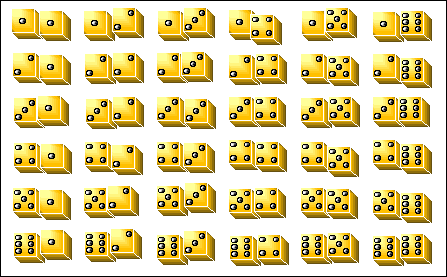
|
| CONDITIONAL PROBABILITY |
| ACTIVITY |
Suppose that you roll two fair dice. All possible
outcomes of this experiment (which is called a sample space)
is given in the following figure. Suppose that you see one of
the dice and it shows 1. Given this information the possible outcomes
of this experiment will change. To see the reduced sample space,
move your cursor on the figure but do not click the mouse.

|
Define the following events
E = "the sum is 7"
F = "at least one of the dice shows a 1"
Note that
P(E)=6/36 and P(F)=11/36
If you see one of the dice and it shows 1, then the
probability of sum being 7 changes to
P(E|F)=2/11=P(E and F)/P(F)=(2/36)/(11/36).
Do you think that seeing a 1 on one of the dice gives
you a probabilistic information on the sum being equal to 7?

|